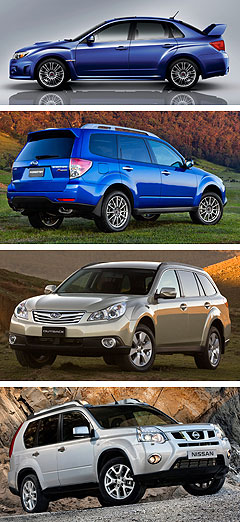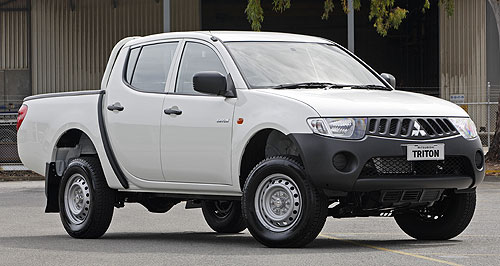Make / Model Search
News - General News - SalesJapanese car doubt after AugustBeneficiary: Mitsubishi recently took a fleet order for 150 Tritons that would normally have been sourced from another company due to the production shortages affecting many brands post-tsunami. Fleets warned to order early for end-of-lease replacements31 May 2011 By JOHN MELLOR JAPANESE vehicle supplies are starting to flow again, but question marks hang over supplies beyond August, with disruptions possible until the end of the year, fleets have been told. This scenario emerged from a briefing by a panel of car company fleet managers from Mitsubishi, Nissan, Subaru, Honda, Ford and Hyundai to corporate fleet managers at an event organised by the Australasian Fleet Managers Association to update the industry on the knock-on effects of the earthquake and tsunami in Japan and the likely availability of replacement cars being available for their employees or lease customers. Final assembly has been resumed, in many cases using parts and assemblies already completed before the earthquake. Some vehicle shipments to Australia are of cars made before the emergency. The issue is how quickly the Japanese supply industry can resume production once the current parts in the pipeline are exhausted. Some key suppliers have been wiped out. Japanese officials are also said to be holding their cards close to their chests and releasing ad-hoc data on a need-to-know basis. The issue of stock availability is especially important for fleets where cars are coming off lease and must be handed back to the leasing company by a due date.  From top: Subaru STi, Forester S-Edition, Outback and Nissan X-Trail. From top: Subaru STi, Forester S-Edition, Outback and Nissan X-Trail.If no replacement car is available due to stock shortages, gaps will appear in the fleet and fleet managers will be forced to seek an alternative brand. Managers were also warned that, with likely shortages to the end of the year, used car values are set to rise and that leasing companies will be anxious to clear off-lease cars as soon as possible to get the highest return possible while the shortage lasts. While supplies in some brands are resuming, mostly at reduced levels, the consensus of the panel was that the situation beyond August was unknown, with many tier four and tier five suppliers being un-contactable since the tsunami. The situation is complicated by power and fuel shortages as well as lost transport infrastructure. Japanese car-makers have shifted to making cars on Saturday and Sunday instead of Thursday and Friday because more power is available at the weekend. Problems experienced at a small number of parts suppliers have caused major concern. Renesas Electronics Corporation, which is world’s number five supplier of automotive microchips, supplies to Subaru, Honda and Toyota among others. Its crucial clean rooms at its Naka wafer fabrication factory in Hitachinaka, Ibaraki, were severely compromised by the earthquake, with equipment damaged. The average vehicle has between 100 and 120 microchips controlling most operating systems, including engines, transmission management, ABS, ESC, airbags, body control systems, climate controls and so on. No car can be built without them. Japanese car-makers have lent 2500 of their own employees to Renesas to help with the recovery. The company was hoping to resume wafer production by the end of July, and the mammoth effort by the industry had rolled than back to early June. But shipments of finished chips are scheduled for the end of August and pre-earthquake volumes are expected by the end of October. Ford Ford, which imports vehicles from Europe and Thailand, has suffered virtually nil impact. Ford says that by mid next year, 85 per cent of the Ford range will be refreshed or totally new vehicles and therefore the company will be in a strong position to supply the market with what it needs. Hyundai Hyundai sources less than one per cent of its parts from Japan, and no cars sold in Australia are affected. But Hyundai warned here was a risk that, if buyers were unable to get supply from other brands, they would turn to Hyundai and that Hyundai dealers in Australia could also experience short supply later this year because its plants are running at near capacity. The company recommended that fleet buyers place orders with dealers at least three months before a replacement car was needed to ensure fleets got another car at the end of lease. Subaru Subaru production has restarted, with the interrupted March production schedule now completed. Some of those cars are earmarked for Australia, with a small number of units now arriving. April production has now started, with those cars expected to arrive in Australia between June and late July. All variants are included because they are based on retailer and manufacturer orders back in January and February. Because of Subaru Australia’s high market share within the Subaru world, Australia has been able to secure additional production from the factory in July. That July production is expected to arrive in Australia from August to mid-September. This will include WRX/STI, Forester (excluding Forester X and diesel variant), Outback (excluding diesel variants) and Liberty with limited supply of 2.5 CVT and no 2.5 manuals. No normally aspirated Impreza or base model Forester, Outback or Forester diesel variants will be available in that additional July production. Events are unfolding on a week-to-week basis and Subaru managing director, Nick Senior, is in constant contact with Japan. The fleet managers were told there was “no visibility on production for Subaru Australia after July”. Replacement parts production resumed in early April. Mitsubishi Mitsubishi lost about 10 days’ production out of Japan because of the sharing of power among manufacturers due to power shortages, and that was expected to be made up by the end of May. So the initial affect in Australia has been a slight delay in vehicles coming out of Japan. Mitsubishi will achieve 100 per cent production in May and June, but 80 per cent production in July. Outside of that window, the company says the view is “less defined” and “ever-changing” as the supply situation changes. The company has received increased demand from fleet customers who would normally buy from other brands, recently taking an order for 150 Tritons that would normally have been sourced from another company. Mitsubishi said most spare parts were available, but about 10 parts were at a “critical level” and on “an emergency order processing system managed through the dealers”. Nissan Nissan said it was fortunate it was holding stock in Australia, stock within dealerships and stock that was about to be loaded on to boats. Stock has been arriving in Australia since mid May. Nissan said it was confident it could maintain supply but remained on a watching brief. Nissan lost three weeks’ production in Japan between March 14 and April 9. The only plant directly affected by the quake, Iwaki, resumed full production on May 17. Production of the X Trail and the Patrol wagon has resumed. Production of the 350Z, Murano, Maxima and the GTR has been delayed, along with Patrol cab-chassis because Nissan was changing plants at the time of the earthquake. Vehicles sourced from the UK, Spain and Thailand are unaffected. Navara D22, Tiida and Micra come from Thailand, while Dualis comes from the UK and the Navara D40, SDX and Pathfinder come from Spain. Nissan Australia said it had secured production in coming months, but international shipping capacity had been cut, with one shipping line cutting shipments of cars to Australia in May from five to two. Honda Honda production was out for two weeks, but all production plants have been open since early April. The supply chain within Japan remains the biggest issue. Eighty per cent of Honda Australia’s cars come from Thailand, which hopes to maintain supply for the foreseeable future. General accessories and replacement parts for existing vehicles on the road are “not an issue”. Honda Australia and dealership stock levels are “very good”. Some model changes had been scheduled for May and Honda backed off on clearing stock of those to continue the supply through to the new models. But, as with the other panelists, Honda could not say what would happen from August. Meanwhile, The Economist has reported that Toyota was short of 500 components after the earthquake. While it has reduced that number to only 30, that remains serious because it only takes one missing component to stop production of a car. According to The Economist, GM, Ford and Chrysler are all affected in the US, and Chrysler could end up losing 100,000 vehicles from 2011 production.  Read more |
Click to shareGeneral News articlesResearch General News Motor industry news |












Facebook Twitter Instagram